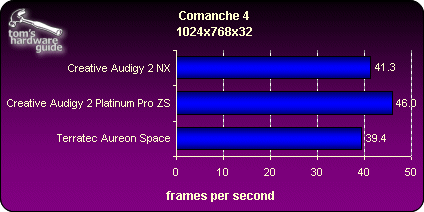USB 2.0 Sound: Creative Labs Audigy 2 NX
3D Sound And Games
If output in 7.1 doesn't contribute much to movie sound - at least in comparison to 5.1 or 6.1 - it improves the sound quality for games considerably. The player's integration into the virtual world of the game would be much more realistic if he/she could be more accurately positioned in it, sound wise, in respect to movement and the location of events. Obviously, any real contribution would depend to a great extent on the configuration available, in terms of the size of the listening area, the quality and arrangement of the loudspeakers, and possible even the acoustics of the room.
The Audigy 2 NX uses the EAX 3.0 Advanced HD, which Creative claims bring a new dimension to the games that use it. EAX 3.0 takes into account, in real time, a change from one atmosphere to another, such as reflected sound and even echoes. A sound heard through a wall will be muffled, for instance. The player can thus get a better idea of where he or she is and position the elements that exist in his or her virtual space.
The way the Audigy 2 NX operates is very different, however, from that of the internal sound cards manufactured by Creative. That is because, while it does indeed use EAX HD, this is basically through an emulation performed by the central processor and not through the on-board circuit on the card. This has obvious repercussions on the processor's workload. Thus, the amount of processor occupied, which is in the order of 14% in the DirectSound 3D hardware, increases to 18% with the EAX. In the standard Creative cards, the rate of processor load decreases with the activation of the EAX, which takes over certain functions through hardware processing. The behavior is thus reversed.
Overall, the Audigy 2 NX cannot be said to be the ideal sound card for the gamer, because the processor load rate is, in all cases, much greater than what can be obtained with a good internal sound card, and in particular, with a Creative Audigy 2 internal card.
As for the Audigy 2 NX's behavior in action game performance, we tested it on Quake 3, Comanche 4 and Splinter Cell, and included two other recent 7.1 cards, the Audigy 2 ZS and the Terratec Aureon Space, as a comparison. With Quake 3, the Audigy 2 NX's performance was noticeably poorer than its internal card rivals. Things were different in the case of Comanche 4, because the NX was well behind the ZS, but it was better than the Terratec. Finally, in Splinter Cell, we found the order we expected, with the ZS doing best and the NX in the rear.
Get Tom's Hardware's best news and in-depth reviews, straight to your inbox.
Current page: 3D Sound And Games
Prev Page Behavior At 24 Bits/96 KHz, Continued Next Page The Software And Configuration


